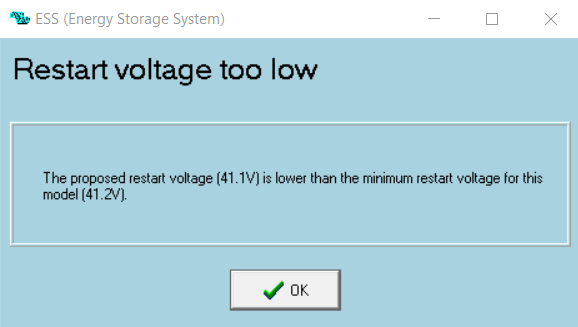After several issues with a firmware update stopping my ESS working with a connected 40A sensor, I am finally getting the system work work as intended but one sticking issue is the voltage will not go below 41.2V, regardless to any settings I adjust. 
41.2V happens to be the minimum inverter restart voltage set out by the ESS assistant and is the only thing I can think is the issue, but why does the inverter cut out at the voltage the inverter should be restarting at, if my assumption is correct. If the DC input low shut down is 37.2V, why does it show down at 41.2v?
To test my assumption, I have set every voltage I can adjust to its lowest setting so see if there is any change, and still no change. Dynamic cut-off all set to 36V & sustain set to 36V in the ESS assistant. DC input shut-down set to 37.2V, DC input low restart set to 41.2V (the same voltage the inverter cuts out at???) My ideal minimum is 38V to maximise the useful energy within the battery whilst maintaining battery longevity.
assistant. DC input shut-down set to 37.2V, DC input low restart set to 41.2V (the same voltage the inverter cuts out at???) My ideal minimum is 38V to maximise the useful energy within the battery whilst maintaining battery longevity.
I have even turned off Battery monitor in the remote console, as well as setting th minimum SOC to 0%, Ive turned off BatteryLife (set it to Optimized (without batterylife), DVCC off, Low battery voltage alarm disabled, still it will not go below 41.2V

